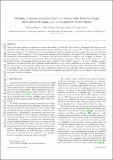| dc.contributor.author | Bucci, Giovanna | |
| dc.contributor.author | Swamy, Tushar | |
| dc.contributor.author | Chiang, Yet-Ming | |
| dc.contributor.author | Carter, W Craig | |
| dc.date.accessioned | 2018-10-12T16:05:17Z | |
| dc.date.available | 2018-10-12T16:05:17Z | |
| dc.date.issued | 2017-08 | |
| dc.date.submitted | 2017-04 | |
| dc.identifier.issn | 2050-7488 | |
| dc.identifier.issn | 2050-7496 | |
| dc.identifier.uri | http://hdl.handle.net/1721.1/118458 | |
| dc.description.abstract | This is the first quantitative analysis of mechanical reliability of all-solid state batteries. Mechanical degradation of the solid electrolyte (SE) is caused by intercalation-induced expansion of the electrode particles, within the constrains of a dense microstructure. A coupled electro-chemo-mechanical model was implemented to quantify the material properties that cause an SE to fracture. The treatment of microstructural details is essential to the understanding of stress-localization phenomena and fracture. A cohesive zone model is employed to simulate the evolution of damage. In the numerical tests, fracture is prevented when electrode-particle's expansion is lower than 7.5% (typical for most Li-intercalating compounds) and the solid-electrolyte's fracture energy higher than G[subscript c]= 4 J m⁻². Perhaps counter-intuitively, the analyses show that compliant solid electrolytes (with Young's modulus in the order of ESE= 15 GPa) are more prone to micro-cracking. This result, captured by our non-linear kinematics model, contradicts the speculation that sulfide SEs are more suitable for the design of bulk-type batteries than oxide SEs. Mechanical degradation is linked to the battery power-density. Fracture in solid Li-ion conductors represents a barrier for Li transport, and accelerates the decay of rate performance. | en_US |
| dc.description.sponsorship | United States. Department of Energy (Grant DE-SC0002633) | en_US |
| dc.publisher | Royal Society of Chemistry (RSC) | en_US |
| dc.relation.isversionof | http://dx.doi.org/10.1039/C7TA03199H | en_US |
| dc.rights | Creative Commons Attribution-Noncommercial-Share Alike | en_US |
| dc.rights.uri | http://creativecommons.org/licenses/by-nc-sa/4.0/ | en_US |
| dc.source | arXiv | en_US |
| dc.title | Modeling of internal mechanical failure of all-solid-state batteries during electrochemical cycling, and implications for battery design | en_US |
| dc.type | Article | en_US |
| dc.identifier.citation | Bucci, Giovanna et al. “Modeling of Internal Mechanical Failure of All-Solid-State Batteries During Electrochemical Cycling, and Implications for Battery Design.” Journal of Materials Chemistry A 5, 36 (August 2017): 19422–19430 © 2017 The Royal Society of Chemistry | en_US |
| dc.contributor.department | Massachusetts Institute of Technology. Department of Materials Science and Engineering | en_US |
| dc.contributor.mitauthor | Bucci, Giovanna | |
| dc.contributor.mitauthor | Swamy, Tushar | |
| dc.contributor.mitauthor | Chiang, Yet-Ming | |
| dc.contributor.mitauthor | Carter, W Craig | |
| dc.relation.journal | Journal of Materials Chemistry A | en_US |
| dc.eprint.version | Original manuscript | en_US |
| dc.type.uri | http://purl.org/eprint/type/JournalArticle | en_US |
| eprint.status | http://purl.org/eprint/status/NonPeerReviewed | en_US |
| dc.date.updated | 2018-09-25T16:53:24Z | |
| dspace.orderedauthors | Bucci, Giovanna; Swamy, Tushar; Chiang, Yet-Ming; Carter, W. Craig | en_US |
| dspace.embargo.terms | N | en_US |
| dc.identifier.orcid | https://orcid.org/0000-0002-5248-8621 | |
| dc.identifier.orcid | https://orcid.org/0000-0002-0833-7674 | |
| dc.identifier.orcid | https://orcid.org/0000-0001-7564-7173 | |
| mit.license | OPEN_ACCESS_POLICY | en_US |
